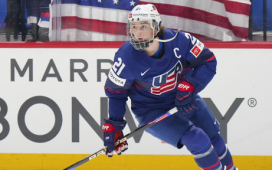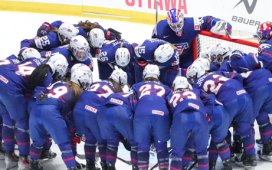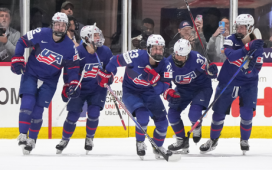It took nearly the entire off-season, but Kyle Connor and the Winnipeg Jets have come to terms on a new contract. And given the terms of his pact, there’s potential for him to make it look like a team-friendly, steal of a deal in a few seasons’ time.

It’s over. It’s finally over. After months of handwringing over the contract negotiations between high-profile restricted free agents and their respective clubs – and with all due respect to Stars defenseman Julius Honka, who is waiting for a one-way ticket out of Dallas – the last domino has finally fallen. Late Saturday night, not all that long after the Colorado Avalanche and Mikko Rantanen put the finishing touches on a six-year, $55.5-million pact, the Winnipeg Jets and Kyle Connor agreed to terms on a seven-year, $50-million deal.
For Connor and the Jets, neither the term or the dollars comes as a much of a surprise. Throughout the off-season, all indications have been the 22-year-old winger would be signing a long-term deal that kept him in town well into the future when he finally put pen to paper, and not even the $7.14-million cap hit is all that far off of early-summer estimates. That’s welcome news for Winnipeg, especially as it’s somewhat lower than some may have expected given the money that had been handed out over the past several weeks, particularly by the Toronto Maple Leafs to Mitch Marner.
While, yes, Marner has outproduced Connor by a significant margin over the past two seasons – the former has 48 goals and 163 points in 164 games to the latter’s 65 goals and 123 points in 158 games – the prevailing belief at the time Marner signed was his contract had potential to be the rising tide that lifted all boats. Put another way, some were of the mind Marner’s $10.89-million cap hit was going to change the equation for all similar RFAs. We got our first true indication that wasn’t going to be the case, though, when Rantanen, who has better numbers over the past two seasons, received nearly $1.6 million less per season, $9.25 million, on a contract of the same length. And Connor’s deal, by comparison, is far and away the friendliest of the bunch. He comes in at $2 million less than Rantanen and a whopping $3.7 million less than Marner, all with an extra year tacked onto the end.
There are a number of reasons Connor’s deal has come in at a comparatively cut rate, of course. As noted, his counterparts in Colorado and Toronto have outproduced him. There’s also the fact Connor only has two full NHL campaigns under his belt, not the three that Rantanen and Marner have put in. In that sense, Connor is less established, so to speak. But the most important factor at play with Connor’s contract seems to be an understanding of the cap situation in Winnipeg. After signing Patrik Laine on Friday, the Jets knew exactly what kind of cap space they had with which to work and put in the effort with Connor to get the deal done under those parameters.
All one needs to do is some simple math to see that’s the case. Prior to Dustin Byfuglien’s decision to take personal leave and subsequent suspension by Winnipeg, the Jets had in the neighborhood of $15.5 million to spend on Laine and Connor. A two-year, $13.5-million deal for Laine eats $6.75 million of that space and Connor’s cap hit leaves roughly $1.6 million available. The result? The Jets, with a few league-minimum salaries also on the books, have just north of the $7.7 million in cap space. That’s enough to bring back Byfuglien and add his $7.6-million cap hit without a corresponding move should he decide to return. That’s well done by GM Kevin Cheveldayoff.
More than make the math work this season, though, Cheveldayoff and Co. hit a sweet spot of sorts with the Connor contract, working out a deal that not only gets him back in the immediate but can bring great value to the Jets in short order.
In his two full NHL campaigns, Connor has shown consistent 30-goal potential and exceeding the high-water mark he set last season when he notched 34 goals and 66 points is well within the realm of possibility. And considering that there’s reason to believe Connor possesses some untapped offense – it’s not far-fetched to see Connor as a 35-goal, 75-point player, particularly not with the weapons in the Jets’ arsenal – chances are if he would have signed a bridge deal, he would have been commanding a significant raise in the not-too-distant future.
Now that he’s in at a fixed price for the long haul, though, it’s more likely than not that Connor’s deal will be among those that becomes far more cost effective long before he hits the final seasons of the pact, a concept with which the Jets are familiar. Though they’re vastly different players with vastly different ceilings, Mark Scheifele’s eight-year, $49-million pact with the Jets back in July 2016 took all of two seasons to become one of the team-friendliest contracts in the entire league. Winnipeg can find themselves in a similar boat with Connor, too, if he continues his offensive growth and builds upon the output that has given him the fifth-most goals and 14th-highest point total among all left wingers over the past two seasons.
The very obvious benefit of Connor’s contract becoming increasingly cap friendly is that it comes at a time when the Jets are navigating some difficult salary waters. This summer was as troublesome as it was going to get for some time, but ensuring there will be no need for another contract negotiation with Connor until the end of the 2025-26 season means Winnipeg can turn its attention elsewhere. Next summer, it will be to Jack Roslovic. In two seasons’ time, there will be another contract negotiation with Laine. And at the same time, Adam Lowry, Andrew Copp and Neal Pionk will be due new deals. But the Jets can approach those knowing that Connor’s deal, and another pay raise for the winger, won’t be a concern until well into the future instead. That gives them cap certainty coming out of a summer in which they had little.
All of this is to say that while Connor’s deal is about what was expected now and likely the exact right price for the winger, he and his contract both have plenty of upside. And if that upside is fulfilled, chances are we’ll look back upon Connor’s deal as one of Cheveldayoff’s best moves during what was inarguably his most difficult summer yet.
Want more in-depth features, analysis and an All-Access pass to the latest content? Subscribe to The Hockey News magazine.








